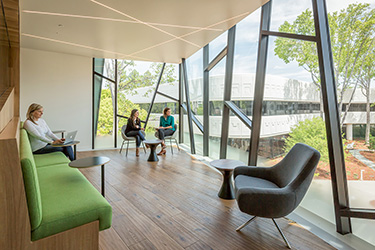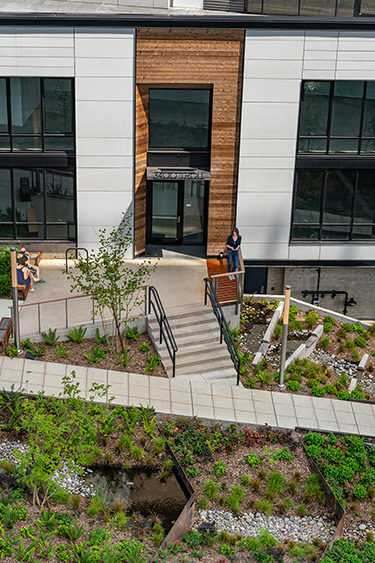|
Subscribe / Renew |
|
|
Contact Us |
|
| ► Subscribe to our Free Weekly Newsletter | |
| home | Welcome, sign in or click here to subscribe. | login |
Architecture & Engineering
| |
December 17, 2020
Local architects are re-thinking post-Covid office design
Special to the Journal
An office is where you work.
Before Covid-19, that meant a daily trip to be with a community of co-workers.
Then came the pandemic. Suddenly, bedrooms and studio spaces in workers' homes were transformed into makeshift offices – complete with high-speed internet, 5G mobile connectivity and Zoom Video conferencing.
The end of the pandemic has forced architects to re-think pre-Covid notions of a safe and productive office, and in 2021 things won't be the same.
Looking forward to a post-Covid-19 world, local architects believe that office designs are on the brink of a transformation. For architects, where they work, as well as the offices they design for clients, will change radically.
As the Covid vaccine rolls-out across the country, the pressure will be on employers to adjust to a new normal for how people work and interact in the office, according to James Woolum, interior design partner with ZGF.
“We're probably reaching a tipping point,” said Woolum. “Once people make the personal choice to return to work, employers may need to find new ways to provide the positive aspects of working from home.”
In other words, workers may be bringing elements of home-office functionality back to the traditional office. Woolum said employers may want to provide physical amenities like gyms, smaller corporate campuses distributed across a region to reduce commute times and more flexible and family friendly policies.
“I think we'll see a meaningful shift from workplace as homebase – the place you go five days a week because that's what's required – to workplace as hospitality hub, a set of places or work-settings you seek out to have meaningful and curated experiences with colleagues or clients.”
Woolum said a “big psychological realignment” will have to take place, starting with assurances that the workplace will be safe.
“Before we set about enticing workers to come back to the office, I think employers will need to continue to cultivate trust around the topics of wellness, health and infection control,” he said.
When it's safe to go back to work, Woolum predicted that more than 20 percent of workers will opt to work from home, at least initially.
Sebastian Hernandez, a senior designer with Gensler, said Covid fast-tracked inevitable changes to workplaces.
“The one-size-fits all solutions targeted at the average worker are no longer viable,” said Hernandez, referring to office design. “The move toward flexibility, autonomy and choice has been accelerated by the pandemic and, as a result, work environments will change radically as employers embrace a hybrid model of work from home and in the office.”
The workplace as a “social club” is another way of describing a workplace hospitality hub, Hernandez said.
“Amenities will, by necessity, change,” he said. “I imagine the future of the workplace to be more akin to a social club comprised of a variety of spaces and experiences that augment the lifestyles of various employees, as opposed to a sea or workstations.”
Cleanliness will take center stage, according to office designers.
“The emphasis on cleaning protocol and fresh air are trends likely to continue to maintain employee comfort and a feeling of security,” he said. “Many of the other safeguards like physical distancing are not likely here to stay, especially once the risk to health and safety has passed.”
BARISTAS AND MUD ROOMS
What office employees have craved since the lockdown, according to Elizabeth Holland, senior principal with Weber Thompson, is re-joining the culture of their companies.
“What will draw our employees back to the office is simply the ability to spend time with their colleagues,” Holland said. “We have been talking a lot about why people want to return to work and the primary answer is to see everyone, to have spontaneous hallway conversations, to cross-pollinate information across project teams.”
Kristen Scott, senior principal with Weber Thompson, said breakout spaces that allow for small groups to brainstorm and share different perspectives have been the missing ingredient of the work-from-home trend.
“There is a unique energy that comes out of humans being together in a space – that frission of ideas,” Scott said.
What Zoom Video can't accomplish, the office can, according to DLR Group's global workplace leader Jeremy Reding.
“The future is more about employees aligning with purpose and place, rather than it is fancy amenities,” said Reding. “It will be about feeling welcomed and connected when you walk in the door.”
A post-Covid office, Reding said, might include a revamped entrance.
“Imagine an employee concierge greeting you on the way in, a barista where reception used to be and a ‘mud room' near the entry allowing you to wash your hands along with any stress you felt on your commute to work,” he said. “Individual desks will be replaced with more collaborative and social spaces, so teams can connect in meaningful ways.”
Offices won't necessarily get smaller, he said, but the mix will change. “I anticipate that overall office square footage will remain approximately the same. However, the ratio of desk-to-collaborative/social spaces will change radically. Look for more shared desks to make room for more collaborative spaces.”
Pierre Barral, SERA Architects' senior workplace leader, said “hospitality-style offices” were trending pre-Covid, and will accelerate their adoption post-vaccine.
“We expect to see more interest in workspaces that are inviting and comfortable, with an emphasis on spaces for people to socialize, adding a barista for example, to help create a space with life and foster interactions.”
Such changes Barral said, “will bring real value to the office as a complement to the home.”
HVAC systems, Barral added, will need to ensure a high amount of air changes per hour and large air intake to avoid re-circulating air.
“These measures,” he said, “are invisible to the naked eye, but they really make a difference.”
And after a year or being cautious about what surfaces we touch in public spaces, Woolum said it's time look at “touchless tech.”
“Modern workplace design considers how friction points can be reduced from an occupant satisfaction standpoint,” Woolum said. “For companies with new spaces and a lot of security concerns, we continue to focus on reducing the amount of times they need to swipe their badges.”
From his perspective, Woolum said, many employees won't miss the repetition and distance of video conferencing.
“Zoom fatigue is a real thing and, I think, contributes to one of the many unforeseen effects of the pandemic,” Woolum said. “Who knew we'd be burned-out on work when we've barely left our homes?”




